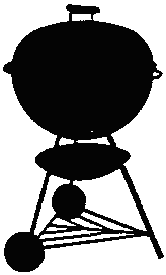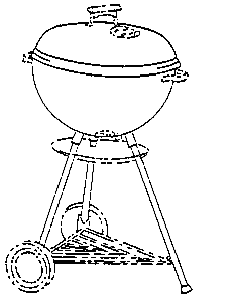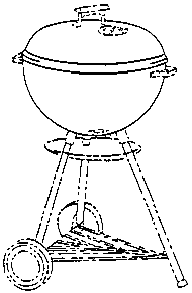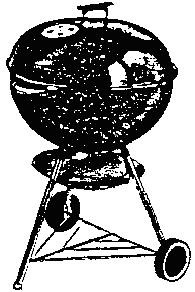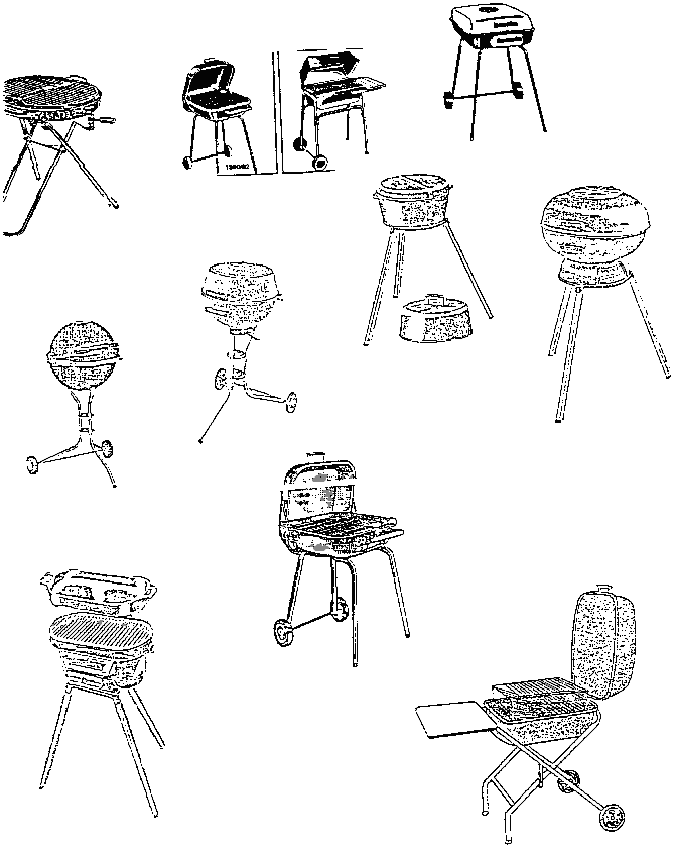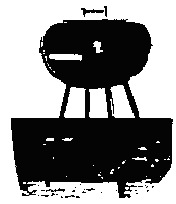Trademark Trial and Appeal Board
Patent and Trademark Office (P.T.O.)
*1 IN RE WEBER-STEPHEN PRODUCTS CO.
Serial No. 181,226; 235,214; 236,009; 236,085
June 24, 1987
Hearing: March 24, 1987
Wallenstein, Wagner, Hattis, Strampel & Aubel for Applicant
Abram I. Sachs
Trademark Examining Attorney
Law Office 8
(Sidney Moskowitz, Managing Attorney)
Before Sams, Rice and Allen
Members
Member
Four applications were filed by Weber-Stephen Products Co. to register certain designs for barbecue grills and/or specified related goods. The first two applications seek registration of a barbecue grill silhouette design (hereafter referred to as the 'silhouette design), as shown below:
The goods listed in the first of these applications (Serial No. 181,226) are griddles and metal grids used as grills and metal grills for holding ears of corn and potatoes, being accessories for barbecue grills, in Class 11, and for accessories for barbecue grills, namely, condiment holders; metal, non-electric rib racks; metal, non-electric roast holders; grill and grill accessory holders; drip pans; and wok pans, in Class 21. [FN1] The goods listed in the second application (Serial No. 235,214) are barbecue grills, in Class 11, and cookbooks, in Class 16. [FN2]
The third application seeks registration of the design shown below (hereafter referred to as the 'kettle body and legs' design)
for barbecue grills, in Class 11. [FN3] The application contains the following description of the asserted mark:
The mark consists of a three-dimensional pictorial representation of the distinctive configuration of the kettle and leg portions of Applicant's barbecue grills. The kettle portion includes a bottom of generally semi-spherical shape having a top of generally semi-ellipsoid shape and supported by three downwardly and outwardly extending legs projecting from the bottom of the bottom portion. [FN4]
The fourth application seeks registration of the design shown below (hereafter referred to as the 'kettle body' design)
for barbecue grills, in Class 11. [FN5] The application contains the following description of the asserted mark:
The trademark consists of a three-dimensional pictorial representation of the distinctive configuration of the kettle portion of Applicant's barbecue grills. The kettle portion include a bottom of generally semi-spherical shape having a top of generally semi-ellipsoid shape.
Registration was refused in all four applications on the ground that the designs sought to be registered are de jure functional configurations of applicant's barbecue grills and hence are unregistrable as trademarks for applicant's barbecue grills (Serial Nos. 235,214; 236,009; and 236,085) and/or for its related goods, namely, grill accessories (Serial No. 181,226) and cookbooks (Serial No. 235,214). [FN6] At oral hearing, [FN7] the Examining Attorney conceded that the refusal on the ground of de jure functionality was not well taken with respect to applicant's cookbooks, and withdrew the refusal to register in Serial No. 235,214 as to those goods. However, the Examining Attorney adhered to the de jure functional ground of refusal with respect applicant's applications to register its designs for barbecue grills (Serial Nos. 235,214; 236,009; and 236,085) and with respect to applicant's application to register its silhouette design for grill accessories (Serial No. 181,226). Thus, the issues remaining to be determined herein are whether applicant's silhouette design, kettle design, and kettle body and legs design are de jure functional configurations of, and hence are unregistable as trademarks for, applicant's barbecue grills, and whether the silhouette design is likewise unregistrable for applicant's grill accessories (it being the Examining Attorney's position that a de jure functional product configuration is unregistrable not only for that particular product but also for goods closely related thereto).
*2 We turn first to applicant's application to register its kettle body and legs configuration for barbecue grills. In support of his refusal to register the configuration on the ground of de jure functionality, the Examining Attorney relies primarily upon a decision of the Board involving a previous application of the applicant; a statement of opinion by a Patent Examiner, with attached copies of two patents; and excerpts from certain of applicant's promotional materials and from responses submitted by applicant herein.
The earlier case cited by the Examining Attorney is In re Weber-Stephen Products Co., 184 USPQ 509 (TTAB 1974), wherein the applicant herein sought to register the overall configuration of its barbecue grill, as shown below,
for barbecue grills. Applicant offered therein evidence and/or arguments to the effect, inter alia, that its president conceived of the idea of selling a kettle-like barbecue grill in 1952 and, during the following three years, developed the idea into a generally round porcelainized sheet metal barbecue grill mounted on a tripod stand which included a bottom utility shelf; that between 1956 and April 1973, applicant sold over one and a half million barbecue grills having this particular configuration; that this barbecue grill design was in its concept arbitrary; that covered barbecue grill housings can be made in a variety of shapes, including square, rectangular, and frustoconical; that the reason for adopting this configuration was that it was distinctive and would serve to identify the goods with applicant, that it did, in fact, so serve; and that while the cover and bowl of a barbecue kettle function to control the cooking fire and to reflect cooking heat inwardly, this is true of a covered barbecue grill housing regardless of its overall shape and regardless of the design and appearance of appurtenant structures. Registration was refused on the ground that what applicant sought to register was a nondistinctive functional configuration of applicant's barbecue grills. The Board affirmed the refusal to register, stating, at page 512:
It is our opinion that the configuration of the barbecue grill in question was designed primarily as a result of a desire to create a new and better functioning barbecue grill and that the intent that it function as a trademark to indicate origin and distinguish applicant's goods was an afterthought resulting from the popularity achieved by the grill over the years and from the fear of possible copying by others of certain features of the grill as demonstrated by the advertisements of other grills made of record by the examiner.
Applicant has acknowledged that the cover and bowl of the barbecue grill act to control the cooking heat inwardly. Applicant, in one of its brochures of record, also states that 'Dampers regulate heat, cover eliminates flame scorching of meat and provides even distribution of heat.' The functional characteristics do not stop with the appearance of the kettle. It seems clear that the triangular grillwork bottom shelf and the tripod stand are functional in concept and use. Applicant's configuration is a combination of functional elements which produces what could be described as a more efficient barbecue grill but not a trademark that may be protected under the registration provisions of the Lanham Act.
*3 The statement by the Patent Examiner (the probative value of this statement, as well as that of the rest of the Examining Attorney's evidence, is discussed hereafter) sets forth his opinion that the configuration of the kettle portion of applicant's barbecue grill performs the dual function of first, defining a heating chamber for the food and heat source, and second, reflecting and circulating the heat evenly so that the food cooks evenly (with respect to this latter function, the Patent Examiner cites part of the text of one of the pieces of promotional matter submitted by applicant, which part reads, 'Weber's original covered design reflects and circulates the heat evenly. Foods cook evenly, perfectly . . .'). The Patent Examiner also states his opinion that the 'configuration of the three legs in combination with the kettle provides the obvious function of supporting the kettle in a stable manner' (citing a patent owned by applicant, namely, Patent No. 4,453,530, which states, inter alia, 'Hemispherical bowl 12 is supported on a tripod leg arrangement 30 . . .') and that applicant's configuration 'would be readily recognized as functional in character.'
The excerpts from applicant's promotional materials and responses cited by the Examining Attorney are listed below:
1. Pages 5 and 6 of applicant's cookbook 'Elegant Fare From the Weber Kettle' and pages 4, 5, and 11 of applicant's cookbook 'Barbecuing the Weber Covered Way' (both filed as exhibits to applicant's response of February 20, 1981), which show that applicant's barbecue grill is intended to be used for cooking food and hence, according to the Examining Attorney, 'irrefutably prove that the goods depicted in the mark on the drawing is [sic] functional.'
2. Applicant's statement, on page two of its response filed May 6, 1982, that 'Admittedly, Applicant's kettle and legs perform a function.'
3. Page 5 of applicant's brochure, 'Be a Weber Winner in 1981'.' (submitted by applicant as Exhibit A to its response filed May 9, 1983), which contains the statement, 'Weber's original covered design reflects and circulates the heat evenly. Foods cook evenly, perfectly . . .'
4. Applicant's statement, on page 3 of its response filed April 1, 1983, that 'While Applicant's kettle and legs obviously perform a function, they perform a function only in the sense of possessing some necessary degree of utility.'
5. The cover of a cookbook entitled 'The Best There Is Charcoal Barbecue Kettles' (submitted as an exhibit to applicant's response of February 20, 1981), which bears the statement, 'Heat travels up the round sides, reflects off cover to cook whole meats all around like an oven.' The Examining Attorney contends that this statement indicates that the shape of applicant's barbecue grill is a choice shape for the purpose.
6. Applicant's statement, on page 14 of its appeal brief, that 'Such catalogs are replete with references to 'covered cooking' and the combined use of a cover and dampers for good cooking results. It is these functional features of its grills and not the specific shape of its grills which Weber has 'touted' in its advertising since the creation of its kettle grill by its President, George Stephen.'
*4 Applicant in turn has submitted a substantial amount of evidence pertaining to the de jure functionality issue. [FN8] That evidence is discussed hereafter in conjunction with our evaluation of the facts in this case under the applicable legal principles.
If the design of a product or a container for a product is so utilitarian as to constitute a superior design which others in the field need to be able to copy in order to compete effectively, it is de jure functional (functional in law) and, as such, is precluded from registration for reasons of public policy. That is, '. . . 'functionality' is determined in light of 'utility,' which is determined in light of 'superiority of design,' and rests upon the foundation 'essential to effective competition' . . .' Thus, the mere fact that a product has utility does not necessarily preclude registration of its configuration; registrability depends upon the degree of design utility. See: In re Morton-Norwich Products, Inc. 213 USPQ 9, 14, 15 (CCPA 1982). Evidence which is useful to demonstrate that a particular design is superior, and hence de jure functional, may include (1) a utility patent that discloses the utilitarian advantages of the design, (2) advertising materials in which the originator of the design touts its utilitarian advantages, (3) facts tending to establish the unavailability to competitors of alternative designs, and (4) facts indicating that the design results from a comparatively simple or cheap method of manufacturing the product or container. See: In re Morton-Norwich Products, Inc., supra, at pages 15-16.
We turn then to an evaluation of the evidence presented in this case, starting with the evidence which relates to the four evidentiary factors specifically mentioned in the Morton-Norwich case.
1. Utility Patents
The first listed Morton-Norwich evidentiary factor is 'a utility patent that discloses the utilitarian advantages of the design'. The record herein includes copies of two patents. Patent No. 4,453,530, dated June 12, 1984 and owned by applicant, is the patent (cited by the Patent Examiner) which contains the statement 'Hemispherical bowl 12 is supported on a tripod leg arrangement 30 . . .' In the patent abstract, the covered invention, a support mechanism for a barbecue grill cover, is described as follows:
A cooking grill consisting of a bowl and a cover includes a support mechanism for supporting the cover on the bowl. The support mechanism includes diametrically-opposed T-shaped brackets that support the cover generally perpendicular to the rim in an open position and provide a partial shield for the cooking surface.
While the drawings in the patent show a cooking grill with a round bowl, supported on a tripod leg arrangement, nothing in the patent discloses any utilitarian advantages of this particular design. Indeed, it is specifically stated in the patent that:
*5 While this invention is susceptible of embodiment in many different forms, there is shown in the drawings and will herein be described in detail a preferred embodiment of the invention with the understanding that the present disclosure is to be considered as an exemplification of the principles of the invention and is not intended to limit the broad aspect of the invention to the embodiment illustrated.
The record also includes a copy of a second patent, namely, Patent No. 4,337,751 dated July 6, 1982, which, like Patent No. 4,453,530, was put into the record at the same time as the statement from the Patent Attorney. According to applicant, this patent is owned by one of its suppliers. The invention in question is a barbecue grill accessory, namely, 'a table for a barbecue grill that may be removed from the grill for use as a serving tray for food, and a support frame for the table which is easily connectable to and removable from the grill.' While the drawings in the patent show a tray and support therefor attached to a cooking grill having a round bowl supported on a tripod leg arrangement, nothing in the patent requires the use of a round bowl or a tripod leg arrangement (to the contrary, as in Patent No. 4,453,530, there is an express disclaimer of any such requirement), nor does the patent reveal any particular utilitarian advantages of such a design. Neither the Patent Examiner nor the Trademark Examining Attorney made any specific mention of this patent that we can find, and we can only surmise that a copy of the patent was put into the file of the case because of one sentence, underlined by either the Examining Attorney or the Patent Examiner. The sentence in question reads, 'Kettle grills such as the grill 10 have bowls 14 which are made in slightly different diameters by different manufacturers.' It appears that the Examining Attorney may have put this patent into the record as evidence that a number of different manufacturers make barbecue grills with round bowls.
In any event, as noted above, neither patent discloses any particular utilitarian advantages to the configuration sought to be registered herein.
2. Applicant's Promotional Materials
The second Morton-Norwich evidentiary factor is 'advertising materials in which the originator of the design touts its utilitarian advantages.' In this case, the only portions of applicant's promotional materials cited by the Examining Attorney which might be construed as touting the utilitarian advantages of the configuration sought to be registered are the statements, 'Heat travels up the round sides, reflects off cover to cook whole meats all around like an oven.' and 'Weber's original covered design reflects and circulates the heat evenly. Foods cook evenly, perfectly . . .'
Additionally, we note applicant's Exhibit B, a combination cookbook and instruction book bearing on its cover the wording, inter alia, 'Weber(R) The one. The only.' and a 1979 copyright date. This booklet, which was submitted with applicant's response of May 9, 1983, bears on page 2 the statement 'There's no rotisserie needed, and no electric cord . . . the round kettle lets you circulate the heat, not the meat' and on page 3 the following (emphasis in original):
*6 It's round for a reason.' Forget the rotisserie and electric cord that ordinary grills need.' Round means rotate the heat, not the meat. Cook faster, more evenly, and save energy.
These statements certainly seem to suggest that there is a utilitarian advantage to the round shape of applicant's grill bowl. However, we cannot say that these statements necessarily indicate that the shape of applicant's involved grill bowl is functionally superior to other grill bowls which are round but which nevertheless have shapes which differ from the shape of applicant's grill bowl, as, for example, round bowls which are not as deep as applicant's, or bowls which are circular with a flat bottom. [FN9] Moreover, we cannot find, in applicant's promotional materials, any statements touting any utilitarian advantages of the tripod leg arrangement.
3. Availability of Alternative Designs
Applicant has made of record pictures of a large number of barbecue grills (both covered and uncovered) of various alternative shapes made by different manufacturers. These include, inter alia, square grills, rectangular grills, circular grills with flat bottoms, and other round or spherical grills whose shapes are nevertheless different from the shape of applicant's grill. Shown below is a sampling of these alternative grill designs, including particularly a goodly number of the covered round designs.
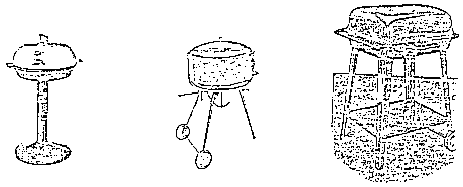
In addition, the record shows that applicant has filed infringement actions against more than ten parties who, in recent years, have sold barbecue grills substantially identical in configuration to applicant's involved configuration. All of those actions ended favorably to applicant, either by the entry of a default judgment against the defendant, or (in one case) with the defendant becoming a licensee of applicant (the licensee has since gone out of business), or by a consent decree in which the defendant consented not to use any configuration which is the same as or confusingly similar to applicant's. Attached to some of the consent decrees was a picture of a round grill which the defendant would be permitted to market, it being agreed by the parties thereto that such grill was not confusingly similar to applicant's. One of those pictured grills is shown below:
The record also contains affidavits and portions of testimony depositions (from the aforesaid civil suits) relating to the availability and efficacy of alternative designs. First, there is the affidavit (submitted May 6, 1982) of applicant's president, Mr. George Stephen, who states that during 1955, he created the precursor model of the modern Weber kettle barbecue grill along with a new method of cooking food using such grill; that his grill consisted of a bowl shape, a grill cover, dampers or vents, and legs attached to the bowl; that his unique grill cover and damper controlled the flow of heat within the grill and provided for an even distribution of heat for cooking numerous foods; [FN10] that the grill body and cover forming the overall shape of the grill were arbitrarily designed, and shaped in such a way as to be distinguishable from other grills found on the market at that time; that in addition, he selected a tripod leg arrangement with one forward leg rather than the four legs or equidistant legs common on most grills at the time; and that while the shape of the original Weber kettle grill has been slightly altered since its creation in 1955, the essential shape of the grill, as formed by the bowl and cover, has been maintained.
*7 Mr. James C. Stephen, who has been a vice president in charge of manufacturing for applicant since 1980 and has been involved in the barbecue industry since 1974, states in his affidavit (submitted July 17, 1986) that applicant was the first party to manufacture kettle-shaped barbecue grills; that applicant's competitors in the barbecue grill market have manufactured and sold square/rectangular and other nonkettle-shaped grills; that some of these competitors have been effectively competing against applicant in the barbecue grill market for at least 25 years; that based upon his experience in the barbecue grill industry and his personal use and testing of various types and shapes of grills, he believes that covered nonkettle-shaped grills produce the same cooking results as kettle-shaped covered grills; that the key to successful barbecue cooking is the effective use of a cover and the correct amount of fuel and not the particular shape of the cooking cavity; and that it is the cover and air flow which control the heat within a barbecue grill and provide for even distribution of heat for cooking.
In his deposition taken March 17, 1982 and May 10, 1982 (portions of which were submitted as Exhibit D to applicant's response of April 1, 1983) in a civil action brought by applicant against a competitor, UNR Industries, Inc., Mr. Michael J. Kempster, Vice President of Marketing and Sales for applicant, testified, in essence, that a covered grill doesn't need a rotisserie; that any covered grill (i.e., any shape which includes a cover) will rotate or distribute the heat around the meat; that applicant's covered round grill cooks similarly to any covered barbecue grill; and that the reason why applicant's covered round grill circulates heat evenly all around the meat is because it is covered, not because it is round. He further testified, on pages 227-228 of his May 10, 1982 deposition, as follows:
Q. Well, is it true to say, 'It is round, so the heat reflects off the porcelain interior and circulates around the meat'?
A. It may or may not be true. We have never conducted any test stating that. All we do know, however, is when you put a lid on the grill or when you procelainize the inside jacket of an oven in your kitchen, for some reason the meat gets brown on all sides. We haven't done any engineering studies that can prove that, but certainly people that use our product or any covered grills have discovered that.
Q. So, you believe that any covered grill will circulate the heat around the meat?
A. Yes, I believe I mentioned that earlier in this deposition. Be it square or rectangular, . . ..
Again, on page 246 of the same deposition, there is the following testimony:
Q. So, on Page 1664, there is a statement, 'The round cover reflects and circulates the heat . . . for even cooking every time.' Does the round bottom or bowl do the same thing?
A. I don't have any idea, Mr. Clement. Again, this is the shape of grill we sell. We design our ad copy to do so. We know that if you put a cover on any grill, no matter what cross sectional shape it is, it will do the same thing: circulate the heat and keep from having flare-ups and burning meat.
*8 The record also contains, on this point, the deposition testimony of officers of two of applicant's competitors. One of the officers, Gunther G. Wackerman, is an officer of UNR Industries, Inc. Mr. Wackerman's testimony was taken on April 7, 1982 in connection with the same civil action as the Kempster testimony quoted above. In his deposition (Exhibit G to applicant's April 1, 1983 response), Mr. Wackerman testified, in effect, that a round grill such as applicant's involved grill does not cook any differently than a circular grill with a flat bottom.
The other competitive officer, Donald E. Karwacky, is president of North American Products, Inc. His testimony was taken in connection with an infringement action filed by applicant against his company (as a result of which his company was permanently enjoined, by consent judgment dated September 10, 1984, from using applicant's barbecue grill kettle configuration or any configuration confusingly similar thereto). In his deposition (Exhibit J to applicant's response of April 1, 1983), Mr. Karwacky testified, with respect to barbecue grills, that to his knowledge there is no significant difference in performance 'between a round smoker and a square smoker'; that food cooks the same on either one of them; and that the 'round smoker' which he himself had had for 15 years was manufactured by applicant.
In summary, the evidence indicates that a wide variety of alternative barbecue grill designs, including other covered round designs, is available to applicant's competitors, and that applicant's covered round design is not superior, in cooking performance, to any of the other covered designs, be they round, square, rectangular, or whatever.
4. Comparative Manufacturing Cost of Applicant's Design
What little evidence there is on this point is circumstantial. It comes, again, from the affidavits and portions of testimony depositions.
First, there are the above-noted statements in the affidavit (submitted July 17, 1986) of Mr. James C. Stephen, VicePresident-Manufacturing for applicant, that applicant was the first party to manufacture kettle-shaped barbecue grills [which applicant has done since 1955, according to the affidavit of its president, Mr. George Stephen]; that applicant's competitors in the barbecue grill market have manufactured and sold square/rectangular and other nonkettleshaped grills; and that some of these competitors have been effectively competing against applicant in the barbecue grill market for at least 25 years.
In his continued deposition of May 10, 1982 (Exhibit D to applicant's response of April 1, 1983), Mr. Kempster, Vice President of Marketing and Sales for applicant, testified as follows (at pages 203-204):
Q. In the first page in the middle of the page on the left-hand side there is a statement, 'We made our gas barbecues round for a reason. No electric cords. No rotisserie. Ever.' What was that 'reason'?
A. Well, the simple fact of the matter was with our presses and tooling and what not, we couldn't make them any other shape economically. That was the real reason from a manufacturing standpoint.
*9 Secondly, we have a patented two-position burner in that particular product and it works better in a covered grill of that shape.
Q. Was either one those the reason that was referred to in this advertisement?
A. No, we did, again, some focus panel groups trying to determine how we could identify our product differently than what the consumer perceived a gas grill to be. The research indicated that people associated a gas grill with a black rectangle. We had a product that worked just as well as covered rectangle grills. We were trying to distinguish it from the competition.
Mr. Kempster's aforesaid testimony indicates that a round grill was more economical for applicant to make because of the presses, tooling, etc. that applicant already had on hand. It does not serve to establish that a round design is necessarily cheaper for all manufacturers, much less that applicant's round grill configuration sought to be registered is cheaper to manufacture than other round grill designs.
Mr. Karwacky, the above identified officer of North American Products, Inc., testified, on pages 25-26 of his deposition (Exhibit J to applicant's April 1, 1983 response), that his company, having manufactured a variety of square smokers over a period of time, decided that the item it needed
. . . to completely finish our line was a line of round smokers. And we explored the possibility of entering that market, and found that most of the tooling required to make that product we already had on hand, because there were many other products which we manufactured within our barbecue line which were no longer active. And we decided that it was fairly inexpensive for us to enter the round smoker barbecue line; and since the market did exist for that product, we decided that it would be in our best interest to add it.
This testimony simply serves to indicate that it was fairly inexpensive for North American Products, Inc. to add round grills to its line of square grills because, as a manufacturer of square grills, the company already had on hand most of the tooling needed to make round grills. The testimony does not suggest that round grills are cheaper to manufacture than square ones.
Finally, two officers of UNR Industries, Inc., namely, Mr. Wackerman and Mr. Buske, testified (in portions of depositions submitted as Exhibits Y and Z, respectively, to applicant's response of May 29, 1986) that UNR's barbecue grill business had not been profitable. As indicated above, UNR was one of the companies sued by applicant for infringement of its round grill configuration.
In summary, the record fails to show that applicant's round grill configuration is cheaper or simpler to manufacture than square designs, rectangular designs, or other round designs.
Having carefully evaluated all of the evidence relating to the four evidentiary factors mentioned in Morton-Norwich, we conclude that such evidence is insufficient to prove that applicant's round grill configuration is a superior design which other manufacturers need to be able to use in order to compete effectively. To the contrary, the weight of the evidence is to the effect that applicant's covered round grill design is similar in cooking performance to any other covered grill, whether it be square, rectangular, a differently shaped round design, or whatever, and that manufacturers of square and rectangular grills have effectively competed with applicant for more than 25 years. Further, we note, with respect to applicant's tripod leg arrangement (with one leg being forward and the other two back), that there is absolutely no evidence in the record to show that it is functionally superior to, or simpler or cheaper to manufacture than, other available leg designs, such as single leg pedestals, four leg designs, or equidistant three-leg designs.
*10 The statement of the Patent Examiner is not persuasive of a different result. First, we note that in a memorandum dated April 8, 1986 (a date well after August 30, 1985, the date when the Patent Examiner's statement was made of record herein), the Commissioner of Patents and Trademarks stated:
While cooperation between trademark examining attorneys and patent examiners is to be encouraged and patent examiners may be authorized to assist a trademark examining attorney in locating patents which would establish the functionality of a configuration sought to be registered, patent examiners are not to be authorized to make written statements or sign affidavits (or declarations) purporting to give expert opinions in connection with the examination of trademark applications.
There is a very serious question, in view of this memorandum, as to whether the Patent Examiner's statement should be given any consideration herein. [FN11] Aside therefrom, his statement indicates only that applicant's kettle grill body and legs perform certain functions. These same functions, however, are shown by the record herein to be performed by any other covered grill, whether round, square, or rectangular, with legs. Thus, the fact that applicant's kettle body and legs perform these functions is not enough, under Morton-Norwich, to support a finding of de jure functionality. Under that decision, the mere fact that a particular article serves the intended function of articles of that type is not sufficient to establish de jure functionality; what must be shown for the purpose is that the design of the article in question is a superior design which competitors need to be able to use in order to compete effectively.
Likewise, the prior Board decision, supra, on applicant's application to register the entire configuration of its round barbecue grill, does not mandate a different result. Aside from the fact that the matter sought to be registered therein was the entire configuration of applicant's grill, rather than the portions thereof sought to be registered here, the present applications have been presented on a much more extensive record than that presented in the prior case, and the evidence in this case indicates that applicant's round grill design is not superior, in cooking performance, to any other covered grill design, whether square, rectangular, or a differently shaped round design.
For the foregoing reasons, the only conclusion we can reach herein which is consistent with the legal principles laid down in Morton-Norwich (a case decided subsequent to the Board's decision on applicant's prior application) is that applicant's kettle body and legs configuration is not de jure functional. [FN12]
Inasmuch as we have concluded that the evidence of record fails to establish that applicant's kettle body and legs configuration is de jure functional, and since we agree with the Examining Attorney that the configuration is not inherently distinctive (that is, we do not think it is of such nature that purchasers would inherently perceive it as an indication of origin), we are of the opinion that the configuration is registrable under the provisions of Section 2(f) of the Act (the Examining Attorney having conceded, as noted above, that the configuration, if not de jure functional, has acquired distinctiveness within the meaning of that section).
*11 For the reasons set forth above, we also conclude that applicant's kettle body configuration, like its kettle body and legs configuration, is registrable under the provisions of Section 2(f) (the evidence in that application being substantially the same as that in applicant's kettle body and legs configuration application).
Turning to applicant's silhouette design, even had we found applicant's three-dimensional configuration designs to be de jure functional, which we did not, we do not see how a blackened silhouette design, that is, a two-dimensional mark, such as that presented in applicant's remaining two applications, could be considered de jure functional with respect to barbecue grills (much less with respect to the grill accessories for which applicant seeks registration in Serial No. 181,226, or the cookbooks for which it seeks registration in the Class 16 portion of Serial No. 235,214). That is, the blackened silhouette, per se, is not a design that can function. Cf. In re Universal Filters, Inc., 218 USPQ 456 (TTAB 1983). The difference between the two-dimensional silhouette design and applicant's three-dimensional product configuration design was recognized in the Board's opinion in the case involving applicant's prior application, at 184 USPQ 509, 511, as follows:
Before proceeding any further, it is necessary to note that while applicant has stated in the application that it has used a representation of its grill in a silhouette form on its printed literature and packaging, the mark that it seeks to register, as disclosed by the drawing of record, is a full blown pictorial representation of the grill which, unlike the silhouette form, outlines every detail of the grill and creates a distinctly different impression than the silhouette form as used by applicant. Thus, our consideration as to the possible functionality of applicant's grill configuration must be directed to that depicted in the drawing and as reproduced above.
Accordingly, we conclude that applicant's silhouette design, also, is registrable under the provisions of Section 2(f) in applicant's application Serial No. 235,214 (which includes barbecue grills, of which the silhouette design is a two-dimensional configuration, albeit not a functional configuration); and that it is registrable on the Principal Register without resort to the provisions of Section 2(f) in applicant's application Serial No. 181,226 (which includes only barbecue grill accessories, of which the silhouette design is obviously not a configuration). [FN13]
Decision: The refusal to register is reversed as to all four applications.
J. D. Sams
J. E. Rice
D. B. Allen
Members, Trademark Trial and Appeal Board
FN1. Serial No. 181,226, filed August 7, 1978, with a claimed date of first use of January 1969.
FN2. Serial No. 235,214, filed October 15, 1979, with a claimed date of first use of April 1955. It is stated in the application that the mark 'consists of a two-dimensional silhouette of the configuration of Applicant's goods'.
FN3. Serial No. 236,009, filed October 22, 1979, with a claimed date of first use of April 1955. The identification of goods at one time included, in addition to barbecue grills, certain specified accessories for barbecue grills, in Class 11, and cookbooks, in Class 16. The accessories were deleted by an amendment filed May 29, 1986, and the cookbooks were deleted by an amendment filed April 15, 1987 (rightly so, since the claimed mark consists of portions of the three-dimensional configuration of, and hence is embodied only in, applicant's barbecue grill).
FN4. In the drawing of the asserted mark, the portions of the grill configuration claimed to constitute the mark are shown in solid lines, while the unclaimed portions of the configuration, including the handles, dampers, wheels, ash catcher, and the grillwork at the bottom of the grill, are shown in broken lines, as is proper. Cf. In re R. M. Smith, Inc., 219 USPQ 629, 633 (TTAB 1983), and In re Ovation Instruments, Inc., 201 USPQ 116, 123 (TTAB 1978).
FN5. Serial No. 236,085, filed October 22, 1979, with a claimed date of first use of April 1955. As in the case of Serial No. 236,009, certain specified accessories for barbecue grills, in Class 11, and cookbooks, in Class 16, were once included in the identification of goods, but were deleted by amendments filed May 29, 1986 and April 15, 1987, respectively. Also, we again note that the portion of the grill configuration claimed to constitute the mark (namely, the configuration of the kettle body) is shown in the drawing in solid lines, while the unclaimed portions of the grill configuration, including the legs, handles, dampers, wheels, ash catcher, and bottom grillwork, are shown in broken lines.
FN6. Registration was also refused in all four cases on the additional ground that applicant's designs were nondistinctive and did not in fact function as marks for applicant's goods (the Examining Attorney not being persuaded by applicant's evidence on the issue). At oral hearing, however, the Examining Attorney conceded that applicant's designs, if not de jure functional, have become distinctive of applicant's goods in commerce, and withdrew the nondistinctiveness ground of refusal.
FN7. Because the four cases present very similar issues, they were consolidated for purposes of briefs and oral hearing, and are being considered in a single opinion.
FN8. In addition to the evidence relating to the issue of functionality, the record contains extensive evidence relating to the issue of distinctiveness (applicant's evidence includes, inter alia, two surveys). Inasmuch as the Examining Attorney conceded at oral hearing that applicant's kettle body and legs configuration, if not de jure functional, has become distinctive of applicant's goods in commerce, we need not discuss the evidence pertaining to the issue.
FN9. In this regard, we note applicant's statement, on page 7 of its response filed April 1, 1983, that in the present application it is not attempting to claim exclusive rights in covered grills or even in circular or spherical covered grills, but rather seeks only protection of its own unique shape. This statement is borne out by a number of consent agreements in infringement suits filed by applicant, as discussed hereafter.
FN10. It is essentially these features (the use of a cover and dampers or vents) which applicant's promotional materials have consistently touted since 1956, i.e., the advantages of controlled, covered cooking.
FN11. We wish to make it clear that we do not criticize the Examining Attorney in this case for using a statement from a patent examiner. As indicated above, the Commissioner's memorandum banning such a practice did not come out until a good many months after the Patent Examiner's statement was made of record herein. Moreover, it is normally quite difficult for an Examining Attorney to obtain evidence in support of his position in a case such as this, and the Examining Attorney in this case is to be commended for his industry in trying to locate such evidence.
FN12. Our conclusion in this ex parte proceeding would not, of course, preclude us from reaching a different result in a subsequent inter partes proceeding brought with respect to these same applications by a competitor of applicant, if the competitor were able to present evidence showing that applicant's configuration is, in fact, superior to other available designs and that competitors need to be able to use it to compete effectively. See: Downtowner Corp. v. Uptowner Inns, Inc., 178 USPQ 105 (TTAB 1973), affirmed in unpublished opinion, 183 USPQ 427 (CCPA 1974). We note in this regard that evidence on such a question is much more readily available to a competitor than it is to a trademark examining attorney.
FN13. Although registration was at one time refused in all four applications under Section 2(e)(1) on the ground that applicant's marks sought to be registered were merely descriptive as applied to the goods specified in the applications, the Section 2(e)(1) refusal was withdrawn in each case prior to appeal.


